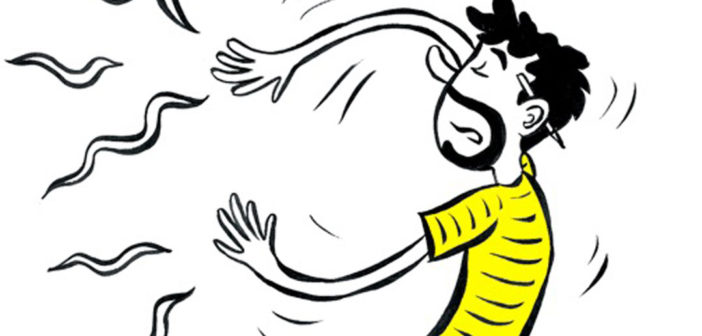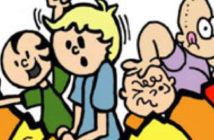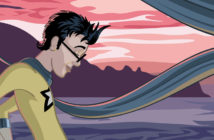I’ve always been both fascinated and perplexed by the concept of the “straight-acting” gay man. What exactly does that mean? Aside from the single homosexual characteristic of a person being both physically and emotionally attracted to his or her own sex, what are the other attributes we should be on the look out for? Physical perfection? Good fashion sense? A popped collar, perhaps? None of those are correct, because I can personally reference a handful of frat boys I’ve met in my life who also exhibit those characteristics, all of whom share the one great fear of being thought of by their “bros” as a “fag.” Just ask sociologist and author Michael Kimmel.
Femininity is the obvious one—at least for gay men, anyway. But what about our friends, the bears? Why, I just finished gushing over Steve MacIsaac’s Shirtlifter series a few weeks ago, and the gay men in his stories are anything but the stereotypical swish gallivanting around the Castro. MacIsaac portrayed men who shaved their heads, embraced bushy facial hair, and flaunted the chiseled bodies of gym-rat bouncers. And aside from bears, what about guys who are simply gay, and that’s it? They don’t embrace their sexuality as a sub-cultural identity? Is that acting straight?
The obvious answer is that there is no such thing as a “straight-acting” gay man. There are just gay men, just like there are just straight men. I won’t touch the bisexuality issue—read a few of Dan Savage’s “Savage Love” columns to learn more about that conundrum. But what’s so interesting about all of this is that I’ve never seen the realities of the gay and lesbian community so clearly defined and passionately communicated since I’ve been introduced to the ever-blossoming plethora of LGBT comics, the most recent of which is Three, an anthology series edited by Robert Kirby.
Aptly titled, the premiere issue of Three collects a trio of short stories, each one touching upon a segment of LGBT life. What’s so lovely about these narratives is their honesty. The three creators in this issue—editor Kirby, Eric Orner, and Joey Alison Sayers—are all simply telling us what the deal is. Kirby and Orner’s stories are emotionally charged, documenting segments of their lives that influenced them along their own journeys, whereas Sayers tells a simple tale of friendship and jest that’s illustrative of who she is and what she already knows about herself. When I finished this comic, I was left a little bit more enlightened.
The first of the stories in Three is Orner’s. Titled “Weekends Abroad,” it catalogues Orner’s travels in Israel. He originally settles down there for his job, but winds up staying for a prolonged period of time due to his contract being continually extended. It’s a classic tale of cultural displacement: Orner does what he can to exist in Israel with some amount of contentment, but he’s a bit of a self-fulfilling prophecy. He’s always telling himself that it’s temporary, so he never takes the genuine steps needed to actually assimilate and build his life. All of this is amplified by his life as a gay man. Living in the United States provides enough trials and tribulations for someone not proudly wrapped in the flag of heterosexuality, but trying to find romantic contentment in an unfamiliar, culturally conservative, and overtly religious country provides its own collection of heartaches.
The approach of Orner’s story isn’t unlike Joe Sacco’s “comics journalism” in that both Orner and Sacco tell personal stories of immersion in the Middle East. The difference is Orner is conveying to us a subjective experience framed around his thoughts and emotions, whereas Sacco tells his story with the sleuthing of a war reporter.
The second story by Joey Alison Sayers, “Number One,” couldn’t be more different in tone, voice, or imagery. It’s a simple yarn about a crew of female landscapers and their relationship to one another versus their clients. The main character, who is nameless but I will take for being an avatar of Sayers, simply needs to use a bathroom. She and her crew drive around and around looking for a place where she can relieve herself, but to no avail. To her chagrin, the final option is to use the client’s personal bathroom. The home’s curmudgeon mistress is waiting outside the door for Sayers’s character to finish, a cloth and bottle of Windex in hand. The client’s concern: did Sayers flush?
I won’t say whether she did or didn’t, but the broader implication of this small exchange shouldn’t be ignored. I remember reading in Barbara Ehrenreich’s Nickel and Dimed about the author’s stint as a maid. The manager of the cleaning service forbad all maids from asking the clients for anything, even so much as a glass of water. Some of the maids that worked alongside Ehrenreich even told her stories of how the wealthier clientele would leave money and pieces of jewelry lying around to test the maids. Sayers’s story is in a similar vein: the hidden (or ignored?) class system in the United States.
The issue is rounded out by Kirby’s “Freedom Flight,” in which our reluctant hero (who I will again assume to be an avatar of the cartoonist) sets out to discover his own destiny. He’s living with a boyfriend much older than he—a professor, in fact, who is ailing of AIDS. As a result, Kirby’s character is troubled: he’s resigned to a role of being the professor’s pet and caregiver, one that doesn’t see much gratitude at that.
Kirby’s character comes off as somewhat neurotic despite his effort in seeing a new potential future every time he looks around his (then) home of New York City. I don’t mean my neurotic label to be insulting: I’m the most neurotic person I know, and I’m always lost in the possibility of what could be in order to ignore the reality of what is. For this, I feel a kinship with Kirby’s story the most. It’s so easy to want something different but so hard to enact it. Whereas, it’s hard to honestly look at what we have, yet quite easy to continually fall back on its reliability.
The premiere issue of Three showcases an amazing ensemble of cartoonists. The artwork in this book is wonderful, as is almost always the case with memoir comics. The illustrations of the storyteller are always instructive of their mind and personality. And from the stories here, everyone has something worth saying. What a lovely collection of stories this turned out to be.
This comic book review originally appeared on Broken Frontier.




